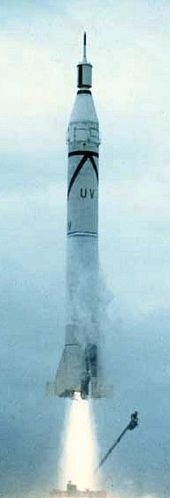Explorer 2
| Explorer 2 | |||||||
|---|---|---|---|---|---|---|---|
| Phase : F / Status : destroyed | |||||||
| Type: | Research satellite | ||||||
| Country: |
|
||||||
| COSPAR designation : | 1958-F02 | ||||||
| Mission dates | |||||||
| Start date: | March 5, 1958, 18:28 UTC | ||||||
| Starting place: | Cape Canaveral , LC-26A | ||||||
| Launcher: | Jupiter-C / Juno I RS / CC-26 | ||||||
| Mission duration: | 168 sec. | ||||||
| End date: | March 5, 1958, 18:31 UTC | ||||||
| General spacecraft data | |||||||
| Takeoff mass: | 14.52 kg | ||||||
| Dimensions: | 203 cm length 15 cm diameter |
||||||
| Manufacturer: | Jet Propulsion Laboratory | ||||||
| Payload data | |||||||
| Instruments: |
|
||||||
| Others | |||||||
| Previous mission: |
Vanguard TV3BU | ||||||
| Subsequent mission: |
Vanguard 1 | ||||||
|
|||||||
Explorer 2 was the second satellite in the Explorer program , which is the first and most extensive program of satellites and spacecraft in the United States. The flight was essentially intended to be a repeat of the successful Explorer 1 mission . However, the 4th stage of the Juno I launcher failed to fire, preventing the satellite from reaching orbit .
Explorer 2 was equipped with a Geiger counter for measuring cosmic rays and an apparatus for detecting micrometeorites.
Individual evidence
- ↑ Explorer 2 in the NSSDCA Master Catalog , accessed May 1, 2017.
- ↑ Gunter Krebs: Explorer: Explorer 1, 2, 3, 4, 5. Accessed on May 1, 2017 (English).

